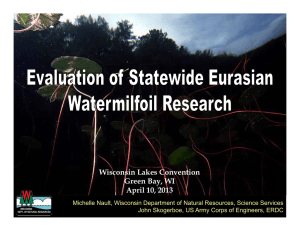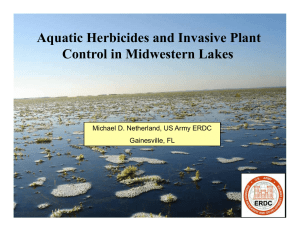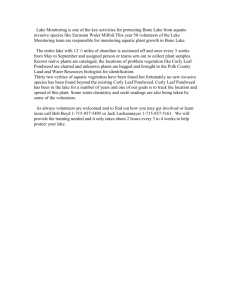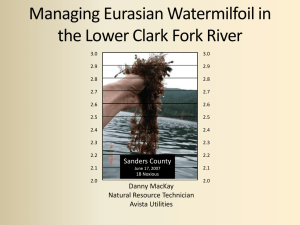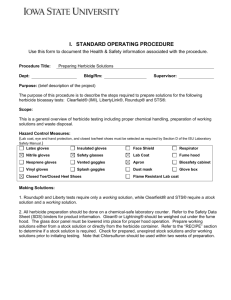Wisconsin Lakes Convention Stevens Point, WI April 23-25, 2015
advertisement
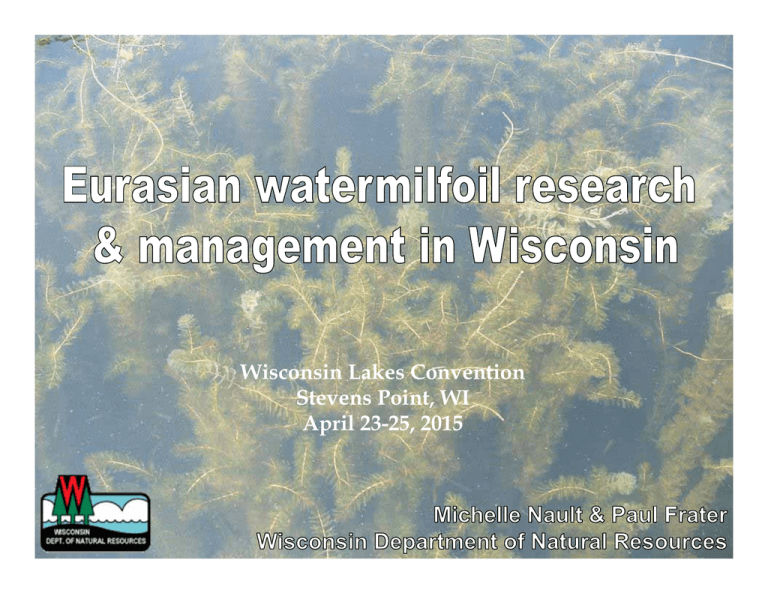
Wisconsin Lakes Convention Stevens Point, WI April 23-25, 2015 Macrophyte Research Standard sampling protocol development Long-Term Eurasian Watermilfoil Trends To support future good data collection To support scientific evaluation of management decisions Native Community Dynamics Herbicide Concentration Monitoring Eurasian Watermilfoil Study What: Collect long-term annual data on the distribution, ecology, and management of EWM Purpose: Create a baseline long-term dataset on EWM populations over time Output: Long-term temporal and spatial EWM & natives trends Northern Lakes & Forests Unmanaged 50 Weber EWM Littoral % FOO Managed 40 30 20 Boot 10 Little Bearskin Manson Bear Paw Hancock 0 2004.520052005.520062006.520072007.520082008.520092009.520102010.520112011.520122012.520132013.520142014.5 2005 2006 2007 2008 2009 2010 2011 2012 2013 2014 Northern Lakes & Forests 60 Unmanaged Managed 50 Kathan EWM Littoral % FOO Sandbar 40 Tomahawk 30 20 10 Connors Silver Arrowhead 7 Island 0 2004.520052005.520062006.520072007.520082008.520092009.520102010.520112011.520122012.520132013.520142014.5 2005 2006 2007 2008 2009 2010 2011 2012 2013 2014 North Central Hardwood Forest 50 Unmanaged Managed EWM Littoral % FOO 40 Montana 30 Round 20 Crystal 10 Crooked 0 2004.520052005.520062006.520072007.520082008.520092009.520102010.520112011.520122012.520132013.520142014.5 2005 2006 2007 2008 2009 2010 2011 2012 2013 2014 North Central Hardwood Forest 40 Unmanaged Managed Loon EWM Littoral % FOO 30 20 Berry Underwood 10 Lulu 0 2004.520052005.520062006.520072007.520082008.520092009.520102010.520112011.520122012.520132013.520142014.5 2005 2006 2007 2008 2009 2010 2011 2012 2013 2014 Southeastern Till Plains 90 80 Gibbs Wingra 70 EWM Littoral % FOO Storrs 60 Ivanhoe 50 40 30 20 10 0 2004.5 20052005.52006 20062006.52007 2007.52008 2008.52009 20092009.52010 20102010.52011 20112011.52012 2012.5 20132013.5 20142014.5 2005 2007 2008 2012 2013 2014 Southeastern Till Plains 70 EWM Littoral % FOO 60 50 Little Green 40 30 20 Turtle 10 Kettle Moraine 0 2004.520052005.520062006.520072007.520082008.520092009.520102010.520112011.520122012.520132013.520142014.5 2005 2006 2007 2008 2009 2010 2011 2012 2013 2014 Methods of Assessing Native Communities • Close to 100 species of aquatic plants in WI • A lake often contains 20‐ 30 species • Analyzing single species is “inefficient, awkward, and unsatisfying.” (McCune and Grace, 2002) Coontail Community Distance Community Similarity / Dissimilarity • Looks at species and abundance in common D = 1 – (2 * sum(C) / S1 + S2) D = 1 – [2 * (5 + 1 + 1 + 2) / (20 + 20)] = 0.55 Similarity / Dissimilarity Across Time • Can perform this for lakes across time • Should indicate major shifts in overall community Similarity / Dissimilarity Across Time • Can perform this for lakes across time • Should indicate major shifts in overall community Community Similarity Matrix 2010 2011 2012 2013 2010 1.00 2011 .93 1.00 2012 .92 .95 1.00 2013 .90 .87 .93 1.00 2014 .88 .85 .88 .93 2014 1.00 Similarity / Dissimilarity Across Time Long‐term vs. Yearly Change Carp removal Alternative Stable States • A shift from one state to another (May 1977) • Due to perturbation of system Tomahawk and Sandbar Lakes Sandbar Tomahaw k Study design Tomahawk • Low dose liquid 2,4‐D (0.5 ppm) treatment to whole lake (May 20, 2008) • Aquatic plant surveys conducted 2006‐2014 • Biomass collected during 2007‐2014 surveys Sandbar • Reference lake – no treatment (2007 ‐ 2010) • Low dose liquid 2,4‐D (0.275 ppm) treatment to whole lake epilimnion (spring 2011 & 2013) • Aquatic plant surveys and biomass collected during 2007‐2014 Tomahawk/Sandbar Biomass Nault et al., 2014. Lake & Res. 30:1‐10 Conclusions • Native aquatic plant communities change over time due to variable factors • It is difficult to assert these changes to “management”; some cases exist where this likely is the reason (e.g. Tomahawk) • The possibility exists of an alternative stable state in some of these systems • Scale of “management” is important Herbicide Monitoring What: Collect and analyze data on herbicide concentration and exposure times, efficacy of milfoil control, and selectivity on native plants under varying ‘real world’ conditions Purpose: To provide recommendations for improving control of invasive aquatic plants and reducing damage to native plants Output: Scientific evaluation of herbicide treatments Nault et al. 2012. Large-scale treatments. NALMS LakeLine 32(1):19-24 Nault et al. 2014. Whole-lake 2,4-D for EWM Control. Lake & Res. 30(1):1-10. Large Scale Treatment Factsheet (PUB-SS-1077 2011) Small Scale Treatment Factsheet (PUB-SS-1143 2014) Barton et al. 2013. Turville Bay Report. (PUB-SS-1120 2013) Nault et al. 2015. Small-scale treatments. NALMS LakeLine. In press. CET Experiments Indoor Growth Chambers • Wide range of herbicide concentrations and exposure times (CET) • Replicated studies • Species sensitivity • Controlled setting Outdoor Mesocosm Tanks ‘Real World’ Management Implementation Considerations • Management goal(s) • Management scale(s) • Lake type, size, bathymetry, water chemistry • Target and non-target plant species • Herbicide products and formulations • Application rates • Timing (seasonality, weather, water temps) • Flowing water, water level management • Integrated management techniques Scale of Treatment Large Small • WI Admin. Code: >10 acres or >10% of littoral zone • WI Admin. Code: <10 acres or <10% of littoral zone • Ecological: Herbicide will be applied at a scale where dissipation will result in significant lakewide concentrations and effects are anticipated on a lakewide scale • Ecological: Herbicide will be applied at a scale where dissipation will not result in significant lakewide concentrations and effects are anticipated on a localized scale 2,4-D Concentration/Exposure Time ‘High’ dose Short exposure Green & Westerdahl, 1990 JAPM 28:27-32 ppmae 2.0 1.5 1.0 ‘Low’ dose Long exposure 0.5 Recommended label rate: 2.0 – 4.0 ppm (Hours) 1.0 ppm = 1.0 mg/L = 1000 ppb Herbicide Exposure Time • Dissipation: horizontal and vertical movement of herbicide within the water column – – – – Treatment area relative to lake Wind Water flow Water depth • Degradation: physical breakdown of herbicide into inert components – Microbial – Photolytic 2,4-D Concentration/Exposure Time Green & Westerdahl, 1990 JAPM 28:27-32 ppmae 2.0 1.5 1.0 ‘Low’ dose Long exposure 0.5 Large-Scale Treatments Recommended label rate: 2.0 – 4.0 ppm (Hours) 1.0 ppm = 1.0 mg/L = 1000 ppb Study Lakes • • • • 20 lakes Variety of lake types Range of sizes and depths Range of trophic status Treatments • Lakewide liquid 2,4-D targets of 0.073 - 0.5 ppm (epilimnetic) • Application rates of 0.25 - 4.0 ppm • 8-100% of lake surface area treated • Early season (spring) treatments • Monitored from 2008-2014 Lakewide Dissipation 26% of lake treated South South Twin Twin Lake, Lake, 2010 2010 2,4-D Herbicide Residuals 2,4-D Herbicide Concentrations 2500 Mean Treated Mean Untreated Lakewide Target Concentration (µg/L ae) Irrigation Limit 2000 1500 1000 500 0 0 7 14 21 Days after treatment 28 35 42 Lakewide Dissipation Mixed Lake Stratified Lake Lakewide Dissipation ForestLake, Lake 2,4-D Herbicide Residuals Forest 2,4-D Herbicide Concentrations 350 5 ft 10 ft Concentration (µg/L ae) 300 15 ft 20 ft 250 25 ft Target Conc. 200 150 100 50 0 0 7 14 21 Days after treatment 28 35 Degradation Models • Majority of models highly significant (p <0.001) • Mean 1-7 DAT ranged from 0.1270.584 ppm • Calculated 2,4-D half-lives ranged from 4-57 days • Irrigation restriction (<0.1 ppm by 21 DAT) exceeded in over half the treatments Milfoil Control ??? Seasonal control No control Damage to some natives Focus area High level of control High damage to natives Long-Term Milfoil Control Pre/Post Native Species 2,4-D Whole Lake Treatments * = negative + = positive Scientific Name, Common Name Group Myriophyllum spicatum , Eurasian water milfoil Dicot Bidens beckii , Water marigold Brasenia scherberi , Watershield Dicot Dicot - <5% <5% - n.s. *** *** - - n.s. <5% Ceratophyllum demersum , Coontail Dicot <5% <5% - n.s. n.s. n.s. <5% Chara spp., Muskgrasses Eleocharis acicularis , Needle spikerush Macroalgae Monocot n.s. n.s. n.s. <5% n.s. - n.s. <5% *** n.s. n.s. n.s. n.s. <5% *** * <5% Elodea canadensis , Common waterweed Monocot n.s. *** - n.s. n.s. <5% n.s. Heteranthera dubia , Water star grass Myriophyllum tenellum , Dwarf watermilfoil Monocot Dicot n.s. <5% <5% - - *** *** * <5% - <5% - Myriophyllum sibiricum, Northern watermilfoil Dicot - <5% - <5% *** Monocot ** *** Macroalgae Dicot n.s. - <5% <5% *** *** n.s. Nitella spp., Stoneworts Nymphaea odorata , White water lily *** *** ** * <5% Najas flexilis , Bushy pondweed *** *** n.s. <5% - <5% - <5% <5% n.s. n.s. Potamogeton amplifolius , Large-leaf pondweed Monocot n.s. *** n.s. n.s. <5% <5% n.s. n.s. Potamogeton epihydrus , Ribbon-leaf pondweed Monocot - - - *** - - - <5% Potamogeton foliosus , Leafy pondweed Monocot - - * - - - - - Potamogeton friesii, Fries' pondweed Monocot - - - - ** <5% - - Potamogeton gramineus , Variable leaf pondweed Monocot <5% <5% n.s. - *** *** * - <5% + n.s. <5% - ** <5% n.s. - * *** n.s. Monocot Monocot * *** n.s. Potamogeton pusillus , Small pondweed Potamogeton richardsonii, Clasping-leaf pondweed Potamogeton robbinsii , Robbins pondweed Monocot n.s. * - - n.s. n.s. n.s. *** Potamogeton strictifolius , Stiff pondweed Monocot - - *** *** <5% <5% <5% - Potamogeton zosteriformis , Flat-stem pondweed Stuckenia pectinata , Sago pondweed Monocot Monocot - - n.s. n.s. + - n.s. - *** *** - <5% <5% Utricularia minor , Small bladderwort Dicot - - - * - - - - Vallisneria americana , Wild celery Monocot *** *** <5% + *** + + * 4 0 -4 7 0 -7 3 0 -3 6 2 -4 7 1 -6 8 1 -7 2 1 -1 7 0 -7 Native spp. Significant Decrease (FOO > 5% ) Native spp. Significant Increase (FOO > 5% ) Net Native spp. Loss/Gain Sandbar Tomahawk Frog Kathan S. Twin '09 S. Twin '10 Berry Wilson n.s. *** *** *** *** *** *** *** * - - Hybrid Watermilfoil • Many misconceptions and misinformation regarding hybrid watermilfoils (M. spicatum X sibiricum; HWM) • Statewide analysis of confirmed or suspected milfoil populations tested through ITS sequencing for hybridity • ~130 lakes in WI have HWM confirmed • There is not one ‘single’ hybrid watermilfoil, but it is rather a genetically diverse group that reflects recurrent hybridization (Zuelling & Thum 2012, JAPM) • Further exploration of hybrid water milfoils and effectiveness of various herbicide treatments • Collaboration with GVSU on variation in lakewide milfoil populations and selection pre vs post treatment • Not all HWM appear to be tolerant to herbicides, but majority show statistically significant differences in % control when compared to pure EWM Confirmed Hybrid Watermilfoil Zuelling & Thum, 2012 Preliminary Findings • Herbicide dissipation is rapid and large scale treatments can result in a whole-lake treatment if the scale of the treatment area is large compared to the overall lake epilimnetic volume • 2,4-D degradation rates and half-lives are variable across different lakes; analysis currently in progress… • Early spring, large scale 2,4-D treatments may result in longer persistence of herbicides than expected; may exceed 0.1 ppm for >21 days • EWM control looks promising, however short-term damage to certain native species may occur and long term effects on biotic and abiotic parameters is uncertain • Hybrid watermilfoils need to be better documented and studied in both field and laboratory • Future research into other herbicides (combos, triclopyr, fluridone) • Herbicide monitoring is important, both to understand treatment efficacy, as well as ecological risks 2,4-D Concentration/Exposure Time ‘High’ dose Short exposure Green & Westerdahl, 1990 JAPM 28:27-32 2.0 ppm 1.5 1.0 0.5 Small scale Treatments Recommended label rate: 2.0 – 4.0 ppm (Hours) 1.0 ppm = 1.0 mg/L = 1000 ppb Preliminary Findings • Actual CET in the field is more difficult to predict and maintain in smaller scale treatments • Aquatic plant data is more difficult to collect and analyze in smaller scale treatments – efficacy of control is variable • Rapid dissipation occurs with both granular and liquid 2,4-D formulations and concentrations were below what laboratory CET analysis recommend for effective control • Future research into sediment porewater and herbicide uptake mechanisms • No “one size fits all” solution - future research into other herbicides (diquat, triclopyr, combos) • Future research into other IPM (hand-removal, DASH, biocontrol, etc.) for small-scale AIS control • Future research into extending exposure time (i.e. barrier curtains) Bureau of Science Services! michelle.nault@wisconsin.gov 920-662-5110 http://dnr.wi.gov/lakes/plants/research/
